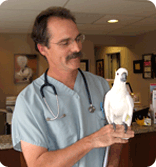Continuous egg laying

My Question: Hello, I’m very worried about my budgie. For less than a year she’s laying eggs continuously! I’ve tried everything, putting her in a cage only with her daughter, but she mated even with her. I have no doubt that they are both female. So, few months ago I also tried to keep her away from all the other budgies, but with no results: she continued to lay eggs for weeks, without break… Her cere has become white. I fear for her health, what should I do?
Thank you in advance!

Claudia - you should schedule a examination and consultation with an experienced avian veterinarian in order to best get you headed in the right direction. Chronic egg laying behavior can become a significant risk factor for life threatening health problem down the road. There likely will be a combination of behavioral, dietary and physical changes that will be needed to control your budgie’s reproductive activities here, and an avian veteirnarian should be capable of advising you on most of these considerations, or refer you to a colleague for same.
An excerpt from a veterinary article I published and presented a year ago:
Chronic egg-laying in the pet bird poses a significant threat to the health and behavioral well being of many pet birds. When a hen lays repeated clutches or larger than normal clutch size without regard to the presence of a normal mate or confined breeding season, a myriad of secondary problems can follow. Ultimately, functional exhaustion of the reproductive tract poses risk of metabolic and physiological drain on the bird, particularly on calcium and energy stores. All of these ultimately predispose the hen to egg binding, dystocia, yolk coelomitis, oviductal impaction, oviductal torsion, cloacal prolapse and osteoporosis. Unlike many of the more common pet domestic mammal species, avian reproductive function is predominately initiated by extrinsic or environmental stimuli, as opposed to intrinsic cyclicity. Once the hypothalamic-pituitary-gonadal axis is triggered, a predictable cascade of events and consequences can occur. These events include endocrine, physiologic, behavioral and anatomic changes and activities in birds. Most non-domestic avian species breed opportunistically, and are reproductively active only when favorable environmental conditions exist. These are typically birds adapted to tropical or desert climates, and, if the climate allows, these birds may breed. In the absence of supportive environmental conditions, reproduction does not occur. In a given year, the proportion of birds in a wild population that actually breed can be low, and some species breed only every other year or every few years. Parrots are mainly monogamous and, in the case of larger species at least, pair for life. The bond between pairs is constantly reinforced by a variety of behaviors, such as allopreening and feeding. This strategy is perhaps adaptive, because of the high proportion of learned (as compared to instinctive) behavior exhibited in parrots: pairs that know each other well and have experience of one another breed more successfully.Environmental cues that can stimulate reproductive activity and ultimately lead to oviposition in avian species include photoperiod, temperature, rainfall, available food supply, the presence of nesting material, and/or the presence of a mate (real or perceived). The perceived photoperiod by birds is understood by many as a very important environmental cue for reproductive activity in most avian species. Its role in parrot species is not as well studied as it is in many other taxonomic groups of birds. Rainfall is known to stimulate reproductive behavior in many tropical and desert-dwelling species of birds. Rainfall and temperature often directly affect the available food supply, which is another critical factor affecting reproductive activity. The presence of nesting sites and appropriate nesting materials is a powerful reproductive cue for many parrot species. Abnormal "mates" can include an owner or other human, some items within the cage, and toys. Another bird housed in the same cage, the same room, or even simply within hearing distance may strongly stimulate reproductive drive. In some species, there is a genetic predisposition for chronic egg-laying and lack of normal reproductive hormonal balance.
Prevention
Many young parrots sold as pets are "mentored" and taught by their new owners only one form of social interactive skills (pair bond enrichment behaviors), as opposed to the typical array of social skills that would have been taught by the parents of their wild counterparts. Deficits in normal social interaction skills, foraging activities, learned inappropriate pair bonding behaviors, inappropriate diets, the provision of nesting environments and other factors are common. The first and foremost component of healthcare and prevention of excessive egg laying comes from the identification of existing risk factors at routine examination, client education, appropriate recommendations, and careful follow up on recommended actions with owners. Recommendations for enrichment of normal lifestyles, positive reinforcement training for guiding flock interactive behaviors, dietary recommendations, foraging training, and cage environment improvements all are essential foundational preventative maneuvers. In essence, enrichment of these types of behaviors is a key aspect of the routine annual examination.
Environmental and Behavioral Interventions
In the presence of excessive egg-laying in companion birds, a series of recommendations and training / enrichments should be outlined for bird owners. Specific recommendations are guided by signalment, history and physical examination findings. Although many of the needed recommendations require the "removal" of reproductively associated stimuli and behaviors, more ethical recommendations should also concurrently package and emphasize the training of normal behaviors to replace what is removed. The stress that can be generated by environmental and behavioral deprivation, although it can add to short-term "effectiveness", should be viewed as less ethical than a behavior-change strategy that is based on differential reinforcement of alternative behaviors. Environmental and behavioral deprivation can easily result in an increase in behavioral problems, ultimately adversely affecting the health and welfare of these patients. In most circumstances and when applied correctly, environmental and behavioral interventions should be viewed as most ethical, least intrusive and most effective treatments for uncomplicated chronic egg laying.
Environmental stimuli may need to be altered, and every recommendation should be carefully balanced with an enrichment or differential reinforcement plan for alternative behaviors. The photoperiod may need to be altered and reduced for some species. Nest sites, toys, and other items to which the bird has a sexual affinity should be removed from the enclosure. Access to a nesting environment (shredded papers, a box, or other dark cavities) should be prohibited. In the event that a pet bird is showing nesting behavior and laying eggs in a designated site within the cage environment, removal of eggs from the nest should be avoided for the normal incubation period for each species to discourage the hen from laying another clutch. Any perceived or actual mate should be removed from the cage or room environment. In some situations, and with some species such as the Cockatiel, visual and auditory separation from a "mate" may be necessary. A "one-person bird," with only a single household member who exclusively handles and cares for the bird should be potentially viewed as an established "mate relationship", which may serve as a trigger for reproductively driven behaviors and activities. Stimulatory petting by the owner, such as rubbing the pelvis, dorsum, and cloacal regions should be stopped. "Flock" interactive behaviors should be encouraged in preference to one person or "mate" interactions in the home. The cage location and internal set up (perches, toys, etc) should be changed and rotated periodically to provide a "new or changing" environment that is less stable and less reproductively stimulating. Inappropriate nutrition that is identified should be corrected to improve the hen's dietary plane to decrease the severity of metabolic drain. Dietary alteration with a reduction of caloric intake appears to significantly reduce or stop egg production with many companion parrot species, as well as enable training and behavior-change strategies.
Medical Therapy
Medical therapies for chronic egg-laying tend to focus on drug therapies to reduce or stop egg production. Pharmacologic options have included medroxyprogesterone acetate, levonorgestrel, human chorionic gonadotropin, Norethidrone/mestranol, testosterone, and leuprolide acetate (Lupron). With the exception of leuprolide, most of these drug or hormonal therapies have variable effectiveness and significant adverse side effects. Although leuprolide acetate appears to be a safe alternative, this product is expensive, requires repeated use, and does not alone correct the causative cascade of reproductive activity in the female bird.
Surgical intervention
Surgical salpingohysterectomy or endoscopic salpingohysterectomy may be indicated in specific patients that are plagued with chronic egg laying problems. Ethically, this option should be pursued only if environmental, behavioral and/or medical therapy has not been successful, the relative risk to the overall health and welfare of the bird is gauged to be significant, and if there is no intent to breed the particular hen. Surgical treatments carry the greatest cost at their outlay, require advanced training in avian soft tissue surgery or endosurgery, and also carry the greatest immediate risk of procedural complications and death. Salpingohysterectomized birds still retain their ovary, and hence may still be predisposed to estrogenic behaviors, hyperestrogenism, cystic ovarian disease, internal ovulation and egg yolk coelomitis.

































